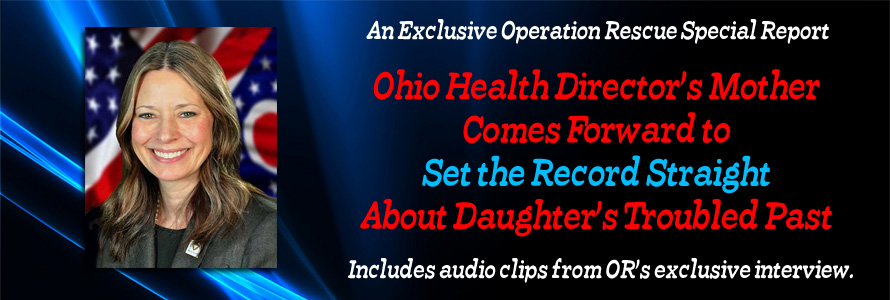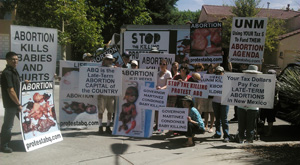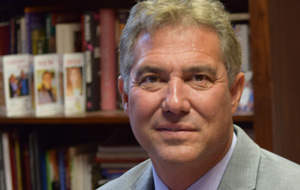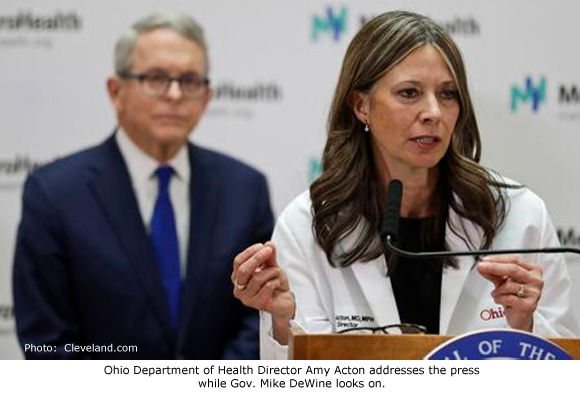
UPDATE 6/11/2020: Amy Acton has announced her resignation as Director of the Ohio Department of Health as of June 11, 2020. Read OR’s press release on her resignation.
A Special Operation Rescue Investigative Report
By Cheryl Sullenger
Columbus, Ohio – She’s been called heroic. The Savior of Ohio. Inspirational. One four-year old child even dressed up like her for “Superhero Day.”
But Operation Rescue has uncovered new information about Ohio Department of Health (ODH) Executive Director Amy Acton that casts doubt not only on her alleged meteoric rise from poverty and abuse, but also on her fitness to serve.
Troubling documentation concerning her past mental state has now come to light. In addition, shocking revelations made to Operation Rescue by Acton’s estranged mother, Donna Arthur, indicates Acton may have exaggerated or outright manufactured details of her childhood hardships, and may have even lied about her alleged abuse at the hands of Arthur’s second husband – lies that Arthur said broke her family irreparably.
“Considering Acton’s involvement in licensing a dangerous Ohio late-term abortion facility after a court upheld a closure order, and considering her actions during the COVID-19 pandemic that shut down churches while allowing abortion facilities to freely operate, we felt it was important for the public to know more about her and her troubled past, as well as her apparent aspirations for the future,” said Operation Rescue President Troy Newman.
Abortion actions raise red flags and prompt a closer look
Acton, was appointed to her role with the ODH in February 2019, by Republican Gov. Mike DeWine, who purports to hold pro-life ideals.
On October 29, 2019, the Ohio Supreme Court ended late-term abortionist Martin Haskell’s appeals in a licensing dispute by upholding the ODH’s right to terminate Women’s Med Center’s abortion license.
While that license was technically terminated, less than a week later, on November 5, Acton approved a license for that exact same facility under a contrived DBA, “Women’s Med Dayton,” which appears to have been created by Haskell — working in concert with Acton – to circumvent the license termination order.
“To us, that seemed like an underhanded move to favor a very dangerous abortion facility and keep it open. That’s when we began looking more into her background,” said Newman. “What we found was quite revealing and put in context many of the disturbing decisions Acton has made during her tenure as ODH chief.”
Operation Rescue learned that Acton was actually a Democrat with ties to pro-abortion organizations.
- Acton previously worked as a grant manager for Ohio non-profits, including Planned Parenthood of Greater Ohio and the NARAL Pro-Choice Ohio Foundation.
- Acton’s liberal political activism included campaigning for Democrat Barack Obama, an avid supporter of abortion.
COVID-19 orders stir anger
Her liberal politics and her willingness to manipulate the rules to favor abortion clinics after having fund-raised for such businesses, raised red flags. Despite this, Gov. DeWine allowed Acton to make drastic decisions regarding measures to control the coronavirus pandemic within the State of Ohio.
Even though Acton issued orders to halt all elective surgical procedures to keep hospitals from being overwhelmed with COVID-19 cases while attempts were made to “flatten the curve,” the state’s abortion facilities never closed.
Attorney General Dave Yost issued letters to Ohio’s abortion facilities, specifically telling them to halt abortions. However, Preterm, a Cleveland abortion facility, sued to stay open.
An e-mail obtained by Operation Rescue through a public records request made to Ohio Attorney General Dave Yost only adds to the confusion about why abortion facilities were allowed to remain open during the COVID-19 restrictions issued by Acton, who took no known actions to shut them down.
The e-mail, sent by Michael L. Rodgers, Director, Policy and Legislation Section of the Office of the Ohio Attorney General on April 14, 2020, to several Ohio legislators addressing their concern about a Sixth Circuit Court decision in the Preterm case is clear as mud.
The Sixth Circuit’s decision does not allow abortion clinics to perform elective or non-essential surgeries. Rather, the Sixth Circuit declined to accept jurisdiction over our appeal because it interpreted the District Court’s temporary restraining order (TRO) as enjoining the Department of Health’s order only in its application to surgical abortions that cannot be delayed. Because the Department of Health’s order does not apply to such abortions, the TRO essentially enjoins the enforcement of the order for procedures to which it does not apply. As such, the TRO actually confirms our position that elective, non-essential surgical procedures performed by Preterm cannot continue under the existing Department of Health order.
So, what does that actually mean?
The Attorney General’s office tried to convince lawmakers that the state was actually successful in halting elective abortions, even though the clinics merely reclassified elective abortions as essential ones – and Acton went along with the charade.
Cost of Acton’s flawed predictions and strict orders
Acton has been accused of using grossly inaccurate models and projections to craft what the OhioStatehouseNews.com called “draconian” measures that have negatively impacted Ohio’s people and economy. Using the now-discredited Imperial College model, Acton initially predicted that in April, there would be 62,000 new cases per day in Ohio – something that never came close to materializing. In fact, as of May 26, 2020, when the article was published, there were never more than 100 new cases a day.
Gov. DeWine refuses to consider that Acton’s orders are an overreach, based on data that is available now, and threatened to veto a bill put forth by the legislature that would have limited Acton’s powers.
OhioStatehouseNews.com reports that Acton continues to suppress the actual number of deaths directly related to the coronavirus by announcing deaths in a confusing way that includes deaths over several days as “in the past 24 hours.”
Acton’s orders shut down legitimate businesses and put thousands of people out of work. Churches closed due to limits Acton put on mass gatherings – limits that did not include abortion facilities, which were seeing record numbers of women in the early stages of the pandemic.
Only after President Donald Trump’s order classifying church services as “essential” did churches in Ohio begin to reopen. They continue to be careful to maintain a list of rules for church-goers, lest they run afoul of Acton’s orders, which carry a misdemeanor penalty for violation of not more than $750, 90 days in jail, or both.
Schools, arenas, theaters, and other areas of entertainment where large gatherings might occur continue to be closed under Acton’s orders.
The cost Acton’s insistence on controlling the lives of Ohioans has been deadly, according to the OhioStatehouseNews.com, which put it this way:
The results: an estimated 2 million unemployed, more than
1,589 nursing home deaths, zero deaths under the age of 30 (but ample
regulations that strap the age group), a startling number of businesses thatwill never re-open, and—if history repeats—a 20%-and-counting increase in suicide.
“What happened in the GOP-controlled state of Ohio was more akin to the devastating impacts seen in Democrat-controlled cities and states where extended shutdowns and control continue to harm their economy and their people,” said Newman. “Ohio suffered because Acton pushed policies favored by Democrats – because she is one. The fact that DeWine protects her makes me question his judgment and his allegiances.”
Mental health/addiction issues
So, what could account for the deception in the handling of the COVID-19 problem and the underhanded way she has dealt with the matter of abortion?
“I’m not going to psychoanalyze, Acton, but it is obvious that she has a troubled past,” said Newman. “Has that played a role in her penchant for duplicity? I’ll leave that for others to decide.”
Yet, it has now been learned that Acton has suffered from mental health and/or addiction issues in the past. Operation Rescue obtained a copy of Acton’s initial medical license application, dated March 25, 1994. In that application, she checked the “yes” box next to the following question:
Have you ever been treated but not hospitalized for emotional or mental illness, drug addiction or abuse, or an alcohol problem? If yes, you must have your treating physician(s) submit a letter directly to the Board on your behalf summarizing dates, of treatment, etc., [sic]

An attempt to obtain the treating physician’s letter related to Acton’s mental illness and/or addiction treatment was denied by the ODH while under Acton’s control.
“I don’t know what her issues Acton had, but I do know someone with that kind of background should be subject to rigorous scrutiny when it comes to holding a powerful position like Director of the ODH,” said Newman. “We know that relapses are common in those with histories of mental illness and addiction, especially when one is subjected to the stresses of a job like Acton’s, which impacts everyone in the state. That and other information leads me to believe that she is not fit to serve in her current position.”
Acton’s estranged mother
Perhaps the most revealing information came in the way of a phone conversation between Operation Rescue and Acton’s estranged mother, Donna Arthur, who initially reached out to share her own concerns about her daughter.
Acton has repeatedly told the story that she was neglected as a child, moved 18 times in the first 12 years of her life, was homeless and living in a tent over one winter, and often did not have food to eat. Acton alleges that her mother was a loose woman who had a “cast of characters” of men in her life, one of which became her step father who abused her when she was between the ages of 9 and 12. Acton also alleges that criminal charges were filed against both her mother and her husband, who “skipped town and have not been heard from since.”
Acton and her younger brother were then placed in the full custody of her biological father. During those years, she claims her life stabilized. “Money was always tight. But they were safe and there was food,” one news story reported.
Donna Arthur tells a different story – one Amy has likely never completely heard. Audio clips from her interview are embedded in the narrative below.
Early life
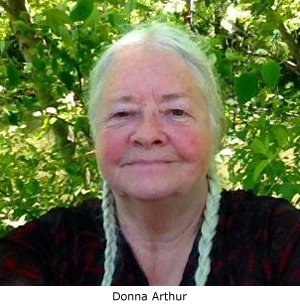
Donna met and married Jerry Stearns, and they made their home in the Youngstown, Ohio, area. But it wasn’t long before he began physically abusing her.
Donna tried to report the domestic abuse she suffered, but at the time, prosecutors in Youngstown were reticent to prosecute such cases.
The family moved to Florida briefly, but Jerry couldn’t or wouldn’t find work. The last straw came one night when Donna asked Jerry about his employment situation. She was seven months pregnant with her son and Amy was just three years old. She claims he beat her in front of Amy, then went across the street to a bar. Donna said that night, she became like a “Mamma Bear.” She put Amy to bed then walked across the street to the bar where Jerry was drinking. He and his friends began to laugh at her, so she hauled off and punched him. She described that act as completely out of character for her, having been raised a pacifist in the Brethren Church.
The family returned to Ohio and divorced soon after that. Amy was three and Donna was still pregnant with Amy’s brother.
“I divorced him because he was violent. I was at a point where I was going to take my own life from what he was doing. It was a typical abuse situation. I was so isolated,” Donna told Operation Rescue. “You don’t get the keys to the car. You don’t ever go anywhere. You don’t ever get any money. So, I went through all this, but I never said this stuff to my children.”
Donna described her ex-husband as a manipulative man who was constantly checking up on her to the point that she often felt she was being stalked. She tried to get a protective order against him, but the judge refused to grant her one.
Donna was a single mom for six or seven years. During that time, she insists they were never homeless, always had food to eat, and always paid her bills. Instead of living in 18 different locations, Donna says there were only four different homes until she married her second husband, Bud, after which there were two more moves.
She was a student during at least part of that time, and was pursuing an education so she could have a career and a better life for herself and her children, who she described as the “center of my life.”
After her graduation with a degree in psychology, Donna said her first job was with Children and Family Services, where she worked with abused women and pushed for prosecutions. It was between the tumultuous years of 1969-1971. She claimed she tried to write about the subject of violence against women for the Vindicator, the Youngstown newspaper, but at that time they were not interested in covering the subject. Instead, she met a Black woman whose husband was on the Board of the NAACP at the time and published a newspaper for the Black Community. Donna said that paper published a couple of her articles.
There was indeed a newspaper for the Black community in Youngstown at that time called the Mahoning Valley Challenger, which was published from 1967-1974, the correct time-frame to validate Donna’s claim. Since the paper shut down long before the Internet, no online archives or owner information is currently available.
Donna’s LinkedIn profile also appears to support her educational and work history claims. It shows she received an Associate in Business, Business Administration degree from Robert Morris College in Pittsburgh, Pennsylvania, a Bachelor’s Degree in Psychology from Youngstown State University, and a Master of Public Administration (MPA) from Penn State University, where she graduated in 2012. While attending school, she volunteered as a counselor and therapist. She now lives in Mechanicsburg, Pennsylvania, where she owns and operates a landscape design business.
Visitation rights
Despite the divorce and spousal abuse, Donna said that Jerry had visitation rights and would take Amy and her brother for overnight stays. At that time, Donna says Jerry had a good job and was making six figures per year, but only paid $40 per month per child in support. She suspected that Jerry had some connections with people of influence who helped him to avoid higher payments.
During the overnights, Jerry would question Amy about various things, including her mom. According to Donna, even when Amy was a young child, her ex-husband would ask Amy “if she ever saw her mother in bed with another guy.”
“It was horrible!” Donna said. She tried to help Amy understand that she did not have to answer such questions.
Donna claimed that Jerry tried to manipulate Amy by buying her things when she was cooperative and not allow her to have things when she was not cooperative. Often, according to her mother, Amy would cry when confessing that she had lied under her father’s questioning.
Finally, when Amy was 12, she accused Donna’s husband, Bud of raping her. Apparently, Bud had a daughter from a previous marriage that had earlier made similar unfounded claims. It is possible that this and suggestions made by her father gave Amy the idea for making that particular accusation.
There was a grand jury investigation and Amy was called to testify. Donna had gone to court that day to support her husband. She was never personally accused or charged with any crime.
There are two accounts of what happened when Amy came out of the grand jury room.
Acton has claimed that she went to kiss her mother, but her mother turned away from her.
Donna claims that she was surprised to see Amy with a new haircut and wearing an outfit that seemed to be not age appropriate for a 12-year old. As Amy come out of the grand jury room, Donna called to her daughter, but Amy turned and went to her father instead.
It was the last time Donna would ever see her daughter.
Donna borrowed $10,000 from her father and hired an attorney who recommended that she and Bud move away for awhile until things could calm down and charges could be dropped. A search of Mahoning County court cases shows there is no record of any criminal charges ever having been filed against Donna or her husband in Mahoning County.
It has pained Donna to read her daughter’s account of their lives together in the news, but she believes that Amy was taught at an early age by her ex-husband, who passed away in 2015, that lies would get her what she wanted in life.
As someone who is trained in psychology and has done social work, Donna is troubled by the way Acton sometimes speaks in a child-like manner. As a practicing Christian, she worries that her daughter is posturing herself for higher office where she might do more damage that just re-licensing an dangerous abortion business or crafting overreaching pandemic orders.
Two sides to every story
Certainly, there are two sides to every story. Amy has repeatedly told her side in very public ways. Now, her mother has finally told her side.
“This new information from her mom, taken together with Acton’s documented history of mental health and/or addiction problems, paints a very troubling picture, to say the least,” said Newman. “If Donna Arthur’s account is true, it means that the head of the Ohio Department of Health may be a very troubled woman. Therefore, out of the abundance of caution and for the protection of the people of Ohio, we at Operation Rescue renew our call for Acton to resign.”

